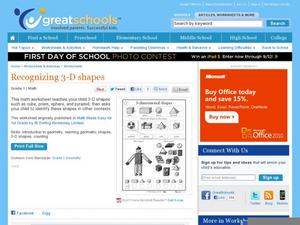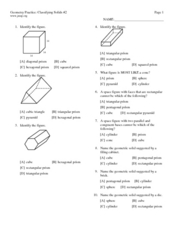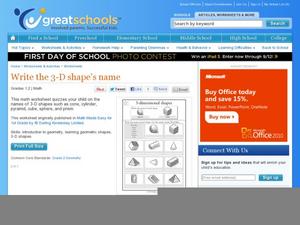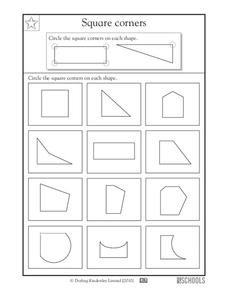Curated OER
Comparing 3-D Shapes
How is a sphere like a prism? Learners compare and contrast 3-D shapes, first drawing each in the boxes provided. If this is too advanced, supply pre-cut images of the shapes for students to choose from and glue onto the learning...
Curated OER
Write the 3-D Shape's Name, Part 2
Geometry can be fun when you know the shapes! Twelve pictures of geometric shapes, including cones, pyramids, and spheres, prompt first graders to write the name of each shape in the space provided. Use the activity as a quiz or homework...
Curated OER
Recognizing 3-D Shapes, Part 2
Take your math lesson to another dimension with this lesson about 3-D shapes! First graders label cones, cylinders, pyramids, spheres, cubes, and prisms, and then count the number of each shape in a collective picture. A great way to...
Math in English
3-D Shapes
Young mathematicians look at five 3-D shapes and name them based on the accompanying image. For each shape, learners state the number of faces, vertices, and edges.
Curated OER
Sorting 2-Dimensional Shapes
Explore shape attributes with young geometers as they sort nine shapes based on their corners. Scholars determine whether or not each shape has a square corner, drawing it in the appropriate space accordingly. They are encouraged to use...
Curated OER
2-Dimensional Shapes: Naming Shapes
Get to know eight shapes by name: square, rectangle, triangle, pentagon, hexagon, and octagon. Young geometers write the correct name below each of these shapes, using a word bank for guidance. Then, they draw two of the...
Math Worksheets 4 Kids
Sorting 2-D and 3-D Shapes
Challenge mathematicians to examine and sort a variety of 2-D and 3-D figures with a 10-problem solid shapes instructional activity.
Mathed Up!
2D and 3D Shapes
What a great assessment to give young mathematicians in order to test their knowledge on two- and three-dimensional shapes. Learners name various shapes, identify the number of edges, faces, and vertices, match an unfolded version of a...
World Wildlife Fund
Arctic Shapes
In a two-part worksheet, young geometers examine 3-D shapes and describe their attributes in a table. They will be able to draw the shape and name the number of vertices, faces, and edges. In the second part, individuals explore...
Curated OER
Recognizing 3-Dimensional Shapes
Three-dimensional shapes are all around us; expose young geometers to this concept as they focus on identifying four figures: cube, prism, sphere, and pyramid. Learners begin by matching four objects to the shape each...
Curated OER
3-Dimensional Shapes
Where is the vertex? Each of these three-dimensional figures is drawn so learners can see all sides and corners. They examine an example before trying six on their own. Some of these will be tricky, so be sure kids have covered this...
Curated OER
Sorting 3-Dimensional Shapes
Three-dimensional shapes can be categorized based on their attributes, and scholars learn more about six figures through this sorting activity. They examine six shapes: sphere, cylinder, cone, cube, prism, and pyramid....
Curated OER
Revise Properties of 3-D Shapes
In this properties of 3-D shapes learning exercise, students identify shape, faces, edges, vertices, and right angles. In this fill in the blank learning exercise, students answer thirty-six problems.
Curated OER
Draw the Shapes Positions as Directed
Following directions is an extremely important skill to master. Learners follow the directions in each sentence. Then they draw specific shapes in specific positions in the provided boxes. A good review resource.
Curated OER
Geometry Practice: Classifying Solids #2
In this solids worksheet, students identify the characteristics of solids. They name solids and determine the number of faces. This three-page worksheet contains seventeen problems. Answers are listed on the last page.
Curated OER
Write the 3D Shape's Name
Can your first graders identify a cone? What about a cube? Or a prism? Help them find the differences between these shapes with this worksheet, which provides a word bank for three-dimensional shapes. For extra practice, bring in...
MENSA Education & Research Foundation
Shapes - Kindergarten
Extend scholars' learning experience with a unit consisting of five shape lesson plans, an extension activity, assessment, and rubric. Begin by reading a story about shapes, then conduct an overview and assign pupils' their first...
Curated OER
What Shape Is That Object?
Before begining this worksheet you will need to clarify if learners are to write the 2-D, 3-D, or both version of each shape shown. They are to write the name of the shape they see. Some may be cones, spheres, or pyramids depending on...
Curated OER
Activities with 3-D shapes.
In this 3D shapes worksheet, students describe faces, feel shapes in a bag, use play dough to make shapes, and more. Students complete 8 activities.
Curated OER
Views of Shapes
In this math worksheet, learners examine the two and three dimensional shapes. They use the observations in order to define the different points of view.
Curated OER
Properties of Polygons, Same-Length Sides
Can your third graders spot the differences between these geometric shapes? After studying several sections of triangles, rectangles, and other polygons, learners circle the shape described in each set of instructions. For extra...
Curated OER
Properties of Polygons, Parallel Sides, and Right Angles
Have fun with shapes! Third graders read a set of instructions and circle the shape in the description. They work on recognizing parallel sides and right sides. Use this resource as homework after your geometry lesson.
Curated OER
Square Corners
Which ones are square corners? As they learn more about shape attributes, be sure scholars understand the difference between a vertex and a square corner. After examining two examples, learners circle the 90-degree corners in 12...
Curated OER
Spotting Polygons
See all sides of the story with a worksheet on geometric shapes! After studying the example at the top, which matches polygons with solid figures, second graders circle shapes that are named in the directions. Next, they match polygons...























